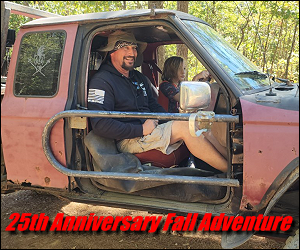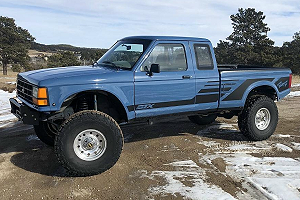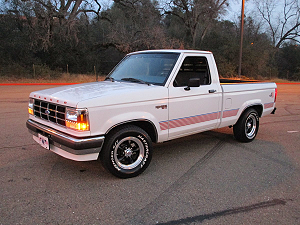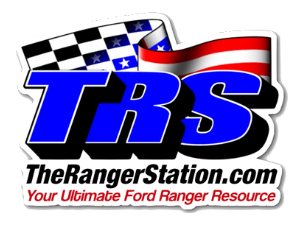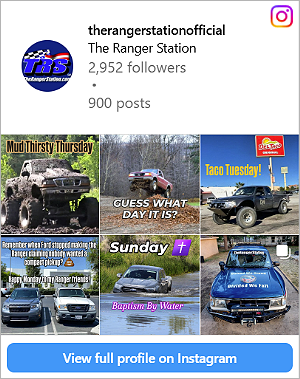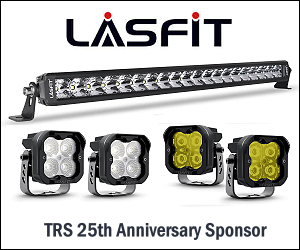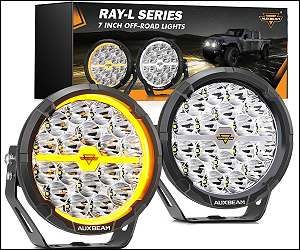- Joined
- Feb 1, 2008
- Messages
- 48
- Reaction score
- 2
- Location
- Oregon
- Vehicle Year
- 2001
- Make / Model
- Ford
- Engine Size
- 4.0 SOHC
- Transmission
- Automatic
Admins: Please sticky this if you feel it's worthy:
--------------
If you have one of these vehicles and you have a high-pitched squeal or whistling coming from the front axle, it’s a good bet your EXCLUDER seals are toast.
Ford TSB # 01-11-4
1998-2001 Explorer
2000, 2001 Ranger
2001 Explorer Sport Trac, Explorer Sport
1998-2001 Mountaineer
This TSB applies to 2001 Explorer Sport/Sport Trac 4X4 vehicles, 1998 - 2001 Explorer/Mountaineer 4X4 vehicles (all build dates), and 2000 - 2001 Ranger 4X4 vehicles built after 11/1/1999 only.
-----------------------
So what are these seals? Quite simply, they are a dust cover that sits behind your wheel hub. They are supposed to keep the dirt and grime from getting into your wheel bearing.
The wheel bearing itself is sealed, so I assume the dust shield is just an extra precaution.
Unfortunately, this seal is poorly designed and is prone to failure (in my opinion). The seal is NOT supposed to spin on the CV joint, however the way it is designed and attached to the CV joint, I don’t see how it will stay in place very long.
Once the seal breaks loose, you’ll get the ever-annoying squeal that sounds like your brakes are metal-to-metal.
These seals have failed 3 times on many Ranger and multiple times on other cars and it seems that Ford doesn't want to do anything about it.
Mine failed twice under warranty and now a third time. Since my extended warranty has expired… Ford told me ‘too-bad-so-sad’ and sent me packing.
Sound familiar?
I plan for a long fight with Ford. All they could say was ‘we’ll look into it’
Well, you can guess how long that’s going to take. In the meantime, I had to fix the seals myself. I wasn’t about to give the dealer or anyone else any more money.
I put together this guide in hopes that some of you DIY’ers can get an idea what you’re up against if you decide to do this on your own. I’ve done extensive searches on the Internet and haven’t found much in the way of pictures for the seal replacement. Even the manual is very vague.
· SAFETY FIRST! Be extremely careful working under cars. Please use the proper equipment such as jack stands, etc…
· REFER TO YOUR MANUAL!
I am by NO means an expert mechanic. I’m a backyard Joe just like many of you. If you pro’s out there have any advice or comments, please feel free to make them. I’m sure this guide isn’t going to be perfect!
------------
In this instance, I’m working with a 2001 Ford Ranger 4x4:
Parts used:
Seal: YL2Z-3K070-AA, Shield, Dust Qty. 2
Axle Nut: N808985-S100 Qty. 2
High Temperature grease
Special Tools used:
Front Hub removal/installer
32mm socket for axle nut


----------------
Loosen your axle nut before you take your tire off. It’s on there with over 160 ft. lbs., so it’s going to be a little fight.
CAUTION: Be extremely careful when raising your car and working under it. Use all precautions and fully secure it. Block your tires; use proper jack stands, etc… SAFETY FIRST!
The manual says to put your transmission in neutral, but I don't see how that applies in this repair. If anything, leaving it IN gear helped secure it from moving on you.
· Raise your car and remove your wheel. I supported the truck with a jack stand and used my floor jack under the A-arm.
I found having the jack under the A-arm with a little pressure helped when removing the ball joint and shock. You can easily move the arm up/down as needed with the jack.
· Remove the disc brake caliper anchor plate bolts.
On the first side of my truck, I removed the caliper, brake pads and THEN the anchor plate. You don't have to do this. You can remove it as an assembly once you remove the anchor bolts.
· Remove your caliper/anchor assembly and secure out of the way. Don’t let it hang by the brake hose. I tied mine out of the way with a piece of wire.
· Remove your brake rotor.
· Remove the axle nut (the manual says DO NOT reuse this ‘torque prevailing nut’) Buy a new one. The part number is shown above.
Ford didn't charge for this nut the last time they repaired the seals, so who knows if they replaced them or not. I did this time just to be sure.
Now it’s time to separate the axle from the hub using the hub puller. It won’t take much effort to separate the axle using the tool.

Once the axle is loose from the hub, remove the bolt that holds the upper ball joint to the wheel knuckle and separate it.
It's going to be a bit tight, so you might want a mallet to help free it from the control arm.
This is where the jack under the A-arm came in handy. I noticed if the A-arm was hanging free, it was hard to get the ball joint to come out. I found that if I jacked the A-arm up a bit and tap the upper control arm with a mallet, the ball joint popped loose.

Now comes a little bit of a fight:
You have to compress the CV joint so you can remove it from the hub and swing it out. I found this step to me a bit of a struggle, as it seems there isn’t enough room to clear the end of the CV joint. The manual doesn’t say anything about separating the tie rod; however after fighting the first side, I removed the tie rod on the second side.
It may even be easier if you separate the lower ball joint instead of the upper one. Maybe someone can comment on this if they’ve done it that way?
EDIT: Thanks to Sasquatch's advice below, it is apparently easier to separate the lower ball joint. I'll do this the next time and get some pictures.


Ok, now with the axle out of the hub, it’s time to remove the CV joint.
The manual says to remove it with a special CV joint fork and slide hammer, but I didn't have one. I used a large screwdriver. Whatever you use, be careful not to damage the CV housing or your axle seal.
The manual also fails to mention that you need to move your shock out of the way. I couldn't get the CV boot past the shock. Now maybe that's because I'm using after-market Rancho shocks... I don't know. I didn't want to chance tearing up my CV boot, so I took the two lower screws off the shock and moved it over.
Once the CV shaft is popped loose, use BOTH hands when removing it from the axle housing. You don't want to damage that axle seal! I can only imagine what a pain in the *ss that would be to replace!

Now in case you’re wondering why you can’t simply install the new excluder seal without removing the CV shaft? Well… I suppose you could, but good luck getting it on correctly.
The seal is very thin and you could easily damage it if you don’t do it right. It’s A LOT easier taking the CV shaft out and putting it in a vice.
Ok, now you have everything out so it's time to CLEAN.
Pry off your old seal if it’s still on the CV shaft. One of mine was on the shaft, and the other wasn’t. Both were a nasty -gritty filthy mess.


Clean all the old grease and dirt from the CV shaft. I also used some emery cloth to clean up the seal surfaces and wash it off with brake cleaner.
Clean the back of the hub where the seal rides. Dig out all the old grease, dirt and grime. I even used Q-tips to get down inside the ring where the seal rides. It was also packed with old nasty grease and road grime. You don't want that to come back out and get into your new seals. Take your time and clean it thoroughly.

--------------
From what I’ve read… CLEANLINESS is vital in reinstalling these seals.
Make sure everything is spotless. Again, I used brake cleaner as it keeps the grease away and dries without any residue.
Once you have everything spick-n-span, it’s time to install that pesky seal on the CV shaft. You might want to skip that next beer until this part is done...

If you look close, you can see a metal ring in the seal (green arrow).
BE CAREFUL AND ONLY PRESS ON THAT STEEL AREA OF THE SEAL!
Otherwise you’ll damage it, then you’re out $20 plus the cost to go get a new one.
Start the seal by hand and then press on the steel part of the seal in equal amounts around the CV shaft. Take your time and be careful.
Ford has a special tool to install this seal, but since I didn’t have one, I used a couple of different things. I found that a 2” PVC coupler fit almost perfectly and only contacted the metal ring. I used that to get the seal most of the way down and then finished it off with small pin-punch. The seal will seat right up against that metal ring and be parallel to the CV joint face.


Whew! Ok, now that the hard part is out of the way, it’s time to lube it all up.
The manual says to ‘spread a 1/8 bead' of high-temp grease on the 'seal lips'.
Once again the manual was less than helpful and vague… which lips? The very outer edge, or the inside?
I went ahead and done both as I figured it wouldn’t hurt. If anything, the force of the shaft spinning should force the grease outwards:

------------------
Now that we’re all lubed up… time to reinstall.
The manual says to use a new C-clip each time the CV shaft is removed. I ended up ordering the wrong clip no thanks to the dealer, so I just reused my old ones. I will post the part number to the C-clip soon as I find out what it is.
Be careful when reinstalling the shaft. Use BOTH hands and be careful not to tear your axle seal!


-------------
Using the hub installer, pull the axle shaft into the hub:

Reinstall the axle nut and tighten as far as you can by hand. You’ll need to final torque once the tire is back on the ground.
Reinstall your upper ball joint, brake rotor, brake caliper, shock (if removed) and tie rod if removed).
Torque everything according to your manual.
For my 2001 Ranger, the toque specs are:
Nut and bolt retaining the upper ball joint: 41 ft. lb.
Front disc brake caliper anchor plate bolt: 85 ft. lb.
Disc brake caliper bolt: 24 ft. lb.
Hub nut/washer assembly: 162 ft. lb.
Wheel lugs: 90 ft. lb.
That's about it! It only took a few hours going slow.
It only took a few hours going slow.
If you're comfortable replacing a ball joint, or axle bearing, then this job shouldn't be too difficult for you.
I recommend getting the proper hub remover and installer tool. I bought the hub puller off EBay and it came with the installer tool.
------------------
In closing, it’s my goal to get Ford to recall their DEFECTIVE parts; however I fear it will be the same as fighting City Hall. It’s up to all of you that have this problem to let them know about it. In this case, it truly is “the squeaky wheel gets the grease”. Hopefully if enough of us complain, Ford will act.
SJ
--------------
If you have one of these vehicles and you have a high-pitched squeal or whistling coming from the front axle, it’s a good bet your EXCLUDER seals are toast.
Ford TSB # 01-11-4
1998-2001 Explorer
2000, 2001 Ranger
2001 Explorer Sport Trac, Explorer Sport
1998-2001 Mountaineer
This TSB applies to 2001 Explorer Sport/Sport Trac 4X4 vehicles, 1998 - 2001 Explorer/Mountaineer 4X4 vehicles (all build dates), and 2000 - 2001 Ranger 4X4 vehicles built after 11/1/1999 only.
-----------------------
So what are these seals? Quite simply, they are a dust cover that sits behind your wheel hub. They are supposed to keep the dirt and grime from getting into your wheel bearing.
The wheel bearing itself is sealed, so I assume the dust shield is just an extra precaution.
Unfortunately, this seal is poorly designed and is prone to failure (in my opinion). The seal is NOT supposed to spin on the CV joint, however the way it is designed and attached to the CV joint, I don’t see how it will stay in place very long.
Once the seal breaks loose, you’ll get the ever-annoying squeal that sounds like your brakes are metal-to-metal.
These seals have failed 3 times on many Ranger and multiple times on other cars and it seems that Ford doesn't want to do anything about it.
Mine failed twice under warranty and now a third time. Since my extended warranty has expired… Ford told me ‘too-bad-so-sad’ and sent me packing.
Sound familiar?
I plan for a long fight with Ford. All they could say was ‘we’ll look into it’
Well, you can guess how long that’s going to take. In the meantime, I had to fix the seals myself. I wasn’t about to give the dealer or anyone else any more money.
I put together this guide in hopes that some of you DIY’ers can get an idea what you’re up against if you decide to do this on your own. I’ve done extensive searches on the Internet and haven’t found much in the way of pictures for the seal replacement. Even the manual is very vague.
· SAFETY FIRST! Be extremely careful working under cars. Please use the proper equipment such as jack stands, etc…
· REFER TO YOUR MANUAL!
I am by NO means an expert mechanic. I’m a backyard Joe just like many of you. If you pro’s out there have any advice or comments, please feel free to make them. I’m sure this guide isn’t going to be perfect!
------------
In this instance, I’m working with a 2001 Ford Ranger 4x4:
Parts used:
Seal: YL2Z-3K070-AA, Shield, Dust Qty. 2
Axle Nut: N808985-S100 Qty. 2
High Temperature grease
Special Tools used:
Front Hub removal/installer
32mm socket for axle nut


----------------
Loosen your axle nut before you take your tire off. It’s on there with over 160 ft. lbs., so it’s going to be a little fight.
CAUTION: Be extremely careful when raising your car and working under it. Use all precautions and fully secure it. Block your tires; use proper jack stands, etc… SAFETY FIRST!
The manual says to put your transmission in neutral, but I don't see how that applies in this repair. If anything, leaving it IN gear helped secure it from moving on you.
· Raise your car and remove your wheel. I supported the truck with a jack stand and used my floor jack under the A-arm.
I found having the jack under the A-arm with a little pressure helped when removing the ball joint and shock. You can easily move the arm up/down as needed with the jack.
· Remove the disc brake caliper anchor plate bolts.
On the first side of my truck, I removed the caliper, brake pads and THEN the anchor plate. You don't have to do this. You can remove it as an assembly once you remove the anchor bolts.
· Remove your caliper/anchor assembly and secure out of the way. Don’t let it hang by the brake hose. I tied mine out of the way with a piece of wire.
· Remove your brake rotor.
· Remove the axle nut (the manual says DO NOT reuse this ‘torque prevailing nut’) Buy a new one. The part number is shown above.
Ford didn't charge for this nut the last time they repaired the seals, so who knows if they replaced them or not. I did this time just to be sure.
Now it’s time to separate the axle from the hub using the hub puller. It won’t take much effort to separate the axle using the tool.

Once the axle is loose from the hub, remove the bolt that holds the upper ball joint to the wheel knuckle and separate it.
It's going to be a bit tight, so you might want a mallet to help free it from the control arm.
This is where the jack under the A-arm came in handy. I noticed if the A-arm was hanging free, it was hard to get the ball joint to come out. I found that if I jacked the A-arm up a bit and tap the upper control arm with a mallet, the ball joint popped loose.

Now comes a little bit of a fight:
You have to compress the CV joint so you can remove it from the hub and swing it out. I found this step to me a bit of a struggle, as it seems there isn’t enough room to clear the end of the CV joint. The manual doesn’t say anything about separating the tie rod; however after fighting the first side, I removed the tie rod on the second side.
It may even be easier if you separate the lower ball joint instead of the upper one. Maybe someone can comment on this if they’ve done it that way?
EDIT: Thanks to Sasquatch's advice below, it is apparently easier to separate the lower ball joint. I'll do this the next time and get some pictures.


Ok, now with the axle out of the hub, it’s time to remove the CV joint.
The manual says to remove it with a special CV joint fork and slide hammer, but I didn't have one. I used a large screwdriver. Whatever you use, be careful not to damage the CV housing or your axle seal.
The manual also fails to mention that you need to move your shock out of the way. I couldn't get the CV boot past the shock. Now maybe that's because I'm using after-market Rancho shocks... I don't know. I didn't want to chance tearing up my CV boot, so I took the two lower screws off the shock and moved it over.
Once the CV shaft is popped loose, use BOTH hands when removing it from the axle housing. You don't want to damage that axle seal! I can only imagine what a pain in the *ss that would be to replace!

Now in case you’re wondering why you can’t simply install the new excluder seal without removing the CV shaft? Well… I suppose you could, but good luck getting it on correctly.
The seal is very thin and you could easily damage it if you don’t do it right. It’s A LOT easier taking the CV shaft out and putting it in a vice.
Ok, now you have everything out so it's time to CLEAN.
Pry off your old seal if it’s still on the CV shaft. One of mine was on the shaft, and the other wasn’t. Both were a nasty -gritty filthy mess.


Clean all the old grease and dirt from the CV shaft. I also used some emery cloth to clean up the seal surfaces and wash it off with brake cleaner.
Clean the back of the hub where the seal rides. Dig out all the old grease, dirt and grime. I even used Q-tips to get down inside the ring where the seal rides. It was also packed with old nasty grease and road grime. You don't want that to come back out and get into your new seals. Take your time and clean it thoroughly.

--------------
From what I’ve read… CLEANLINESS is vital in reinstalling these seals.
Make sure everything is spotless. Again, I used brake cleaner as it keeps the grease away and dries without any residue.
Once you have everything spick-n-span, it’s time to install that pesky seal on the CV shaft. You might want to skip that next beer until this part is done...

If you look close, you can see a metal ring in the seal (green arrow).
BE CAREFUL AND ONLY PRESS ON THAT STEEL AREA OF THE SEAL!
Otherwise you’ll damage it, then you’re out $20 plus the cost to go get a new one.
Start the seal by hand and then press on the steel part of the seal in equal amounts around the CV shaft. Take your time and be careful.
Ford has a special tool to install this seal, but since I didn’t have one, I used a couple of different things. I found that a 2” PVC coupler fit almost perfectly and only contacted the metal ring. I used that to get the seal most of the way down and then finished it off with small pin-punch. The seal will seat right up against that metal ring and be parallel to the CV joint face.


Whew! Ok, now that the hard part is out of the way, it’s time to lube it all up.
The manual says to ‘spread a 1/8 bead' of high-temp grease on the 'seal lips'.
Once again the manual was less than helpful and vague… which lips? The very outer edge, or the inside?
I went ahead and done both as I figured it wouldn’t hurt. If anything, the force of the shaft spinning should force the grease outwards:

------------------
Now that we’re all lubed up… time to reinstall.
The manual says to use a new C-clip each time the CV shaft is removed. I ended up ordering the wrong clip no thanks to the dealer, so I just reused my old ones. I will post the part number to the C-clip soon as I find out what it is.
Be careful when reinstalling the shaft. Use BOTH hands and be careful not to tear your axle seal!


-------------
Using the hub installer, pull the axle shaft into the hub:

Reinstall the axle nut and tighten as far as you can by hand. You’ll need to final torque once the tire is back on the ground.
Reinstall your upper ball joint, brake rotor, brake caliper, shock (if removed) and tie rod if removed).
Torque everything according to your manual.
For my 2001 Ranger, the toque specs are:
Nut and bolt retaining the upper ball joint: 41 ft. lb.
Front disc brake caliper anchor plate bolt: 85 ft. lb.
Disc brake caliper bolt: 24 ft. lb.
Hub nut/washer assembly: 162 ft. lb.
Wheel lugs: 90 ft. lb.
That's about it!
If you're comfortable replacing a ball joint, or axle bearing, then this job shouldn't be too difficult for you.
I recommend getting the proper hub remover and installer tool. I bought the hub puller off EBay and it came with the installer tool.
------------------
In closing, it’s my goal to get Ford to recall their DEFECTIVE parts; however I fear it will be the same as fighting City Hall. It’s up to all of you that have this problem to let them know about it. In this case, it truly is “the squeaky wheel gets the grease”. Hopefully if enough of us complain, Ford will act.
SJ
Last edited:



